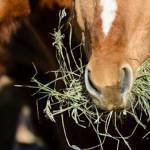Effects of Diet on Horse’s Digestive Tract

The end effect that consumption of a diet has on the gastrointestinal tract is a function of physical form of the diet, percent concentrate compared to percent forage in the diet, chemical composition of the diet, and feeding rate. These factors govern both the utilization of feeds and chemical and microbiological changes that occur in the tract in response to feeding.
Obviously, the closer a feeding program is to the natural manner in which the horse evolved to eat, the smaller the negative effect on gut health and function. Radical departures from small continuous meals consisting of predominantly forage result in the largest effects on gut stability.
A study by J.G. Willard compared cecal pH and volatile fatty acid production in cecally fistulated horses fed either an all-hay or all-concentrate diet. Horses fed a diet of mixed hay showed smaller changes in cecal pH than horses consuming sweet feed. In addition to the noted difference in cecal pH, the molar percentages of volatile fatty acids were different between the two diets. Horses consuming the all-hay diet had higher molar percentages of acetic and lower molar percentages of propionic acid in the cecal fluid when compared with horses on an all-concentrate diet.
Willard further reported that the horses consuming all-concentrate diets spent more time chewing wood and practicing coprophagy (eating of manure) than did horses on the all-hay diet. Interestingly, both wood-chewing behavior and coprophagy were reduced when 62.5 ml of 20% sodium bicarbonate was infused hourly into the cecum of the all-concentrate-fed horses.
Researchers at Cornell University compared digestion coefficients, blood glucose levels, and volatile fatty acid production in ponies fed varying forage:grain ratios. They reported that as concentrate intake increased from a 1:0 forage:grain ratio to a 1:4 forage:grain ratio, molar percentages of acetate decreased and propionate increased. However, they failed to see any associative effects on the digestibility of fiber as the forage:grain ratio changed. Digestibility of dry matter, crude protein, neutral detergent fiber, and available carbohydrate was greater for higher concentrate diets than for the all-forage diet.
Studies by S. Radicke and coworkers reported the response of cecal pH to the feeding of graded levels of starch from oats and corn. A cecal pH of 6.0 represented subclinical cecal acidosis that represented significant risk to the stability of cecal fermentation and a greater chance of colic or laminitis. Chronic exposure to low pH in the cecum also predisposes horses to loss of appetite.
Plasma volume has been shown to decrease as much as 24% in response to large meals and was accompanied by an increase in plasma protein. Large, infrequently fed meals also increase rate of passage of ingesta through the gastrointestinal tract, and this rapid passage may lead to a greater amount of highly fermentable carbohydrate entering the large bowel. Consequences of soluble carbohydrate in the large intestine are increased microbial fermentation, decreased cecal and colonic pH, and increased production of gases derived from fermentation. Decreased cecal pH may initiate a serious and detrimental chain of events including alteration of the microbial flora, release of endotoxins, damage to the mucosa of the cecum and colon allowing for absorption of endotoxin, acute colitis, flatulence, colic, and laminitis.
Horse owners should be aware that the practice of feeding large grain meals rather than continuous feeding of fiber can have serious negative physiologic consequences.








